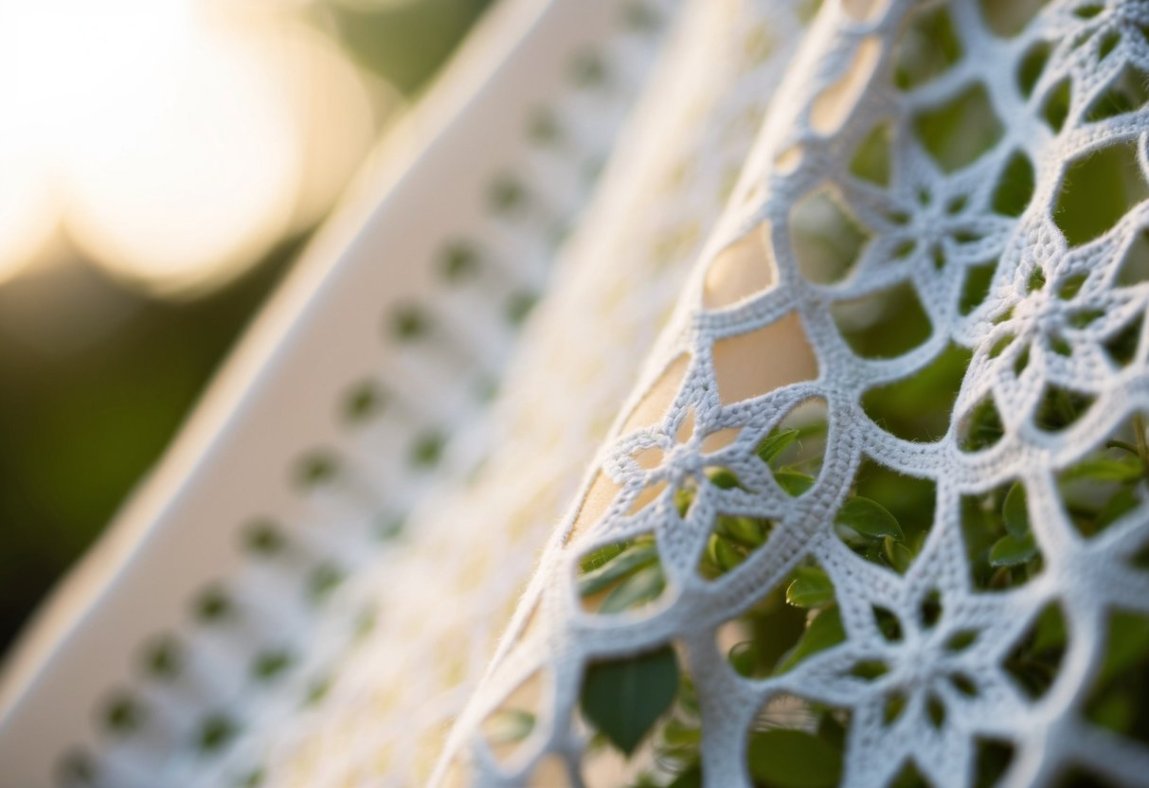Discover the intricate charm of this airy textile with a complete exploration of its origins, properties, and versatile warm-weather applications
Eyelet fabric creates a delicate and airy appearance with its distinctive pattern of small, decorative cut-outs surrounded by embroidered edges. This charming material features patterned holes finished with embroidered stitching throughout the fabric, making it both decorative and lightweight.
The popularity of this fabric stems from its versatility and breathable nature. Its lacy or ornamental selvage makes it perfect for creating beautiful hems, sleeves, and necklines in garments. Knit eyelet varieties offer additional stretch and drape, while maintaining the characteristic open-work pattern.
On This Page
Key Takeaways
- Eyelet fabric features small cut-out holes with embroidered edges for a decorative, breathable design
- The fabric comes in various types, including cotton and wool, with different stretch properties
- Eyelet material works beautifully for summer clothing and decorative trim details
Characteristics of Eyelet Fabric
Eyelet fabric features distinctive perforated patterns reinforced with embroidery, typically made from cotton blends or synthetic materials. The fabric’s unique construction creates an airy, lightweight textile that maintains structural integrity.
Material Composition
Eyelet fabric commonly uses a blend of 65% polyester and 35% cotton for durability and comfort. This blend ratio provides an ideal balance of breathability and strength.
Pure cotton eyelet fabrics offer excellent breathability and softness, making them popular for summer garments. Silk eyelet variants provide a luxurious drape and sheen, though they are less common.
Modern polyester eyelet fabrics offer enhanced durability and wrinkle resistance. These synthetic versions maintain their shape well after washing.
Distinctive Features
The fabric’s defining characteristic is its pattern of small, decorative cut-outs bordered by embroidered stitching. These holes are precisely cut and reinforced using buttonhole stitches to prevent fraying.
Many eyelet fabrics incorporate scalloped edges along their borders. These decorative edges create natural, finished hems ideal for sleeves and necklines.
The embroidered holes can form various patterns:
- Floral designs
- Geometric shapes
- Linear arrangements
- Abstract patterns
The fabric’s construction creates a semi-sheer appearance, with the density of holes affecting the overall transparency.
Types of Eyelet Fabric

Eyelet fabric comes in several distinct varieties, each offering unique characteristics and textures. The fabric type affects its durability, appearance and ideal uses.
Cotton Eyelet
Cotton eyelet stands as the most popular and traditional choice. Its breathable nature makes it perfect for warm-weather clothing.
Knit eyelet cotton features larger mesh sizes and provides four-way stretch. This variation offers excellent draping qualities whilst maintaining its shape.
Traditional cotton eyelet works brilliantly for summer dresses, blouses, and children’s wear. The fabric’s natural fibres allow for:
- Enhanced breathability
- Easy care and washing
- Excellent colour retention
- Soft texture against skin
Silk Eyelet
Silk eyelet fabric offers a luxurious alternative with its smooth, lightweight feel. The material creates an elegant drape and subtle sheen.
Key characteristics include:
- Superior softness
- Delicate sheen
- Excellent draping qualities
- Premium appearance
This premium fabric works especially well for:
- Evening wear
- Special occasion dresses
- Formal blouses
- Wedding attire
Synthetic Eyelet
Synthetic eyelet fabrics, primarily made from polyester, provide practical benefits at a lower cost. These materials offer strong durability and easy maintenance.
Modern synthetic eyelets feature improved textures that closely mimic natural fibres. They excel in:
- Wrinkle resistance
- Colour fastness
- Shape retention
- Quick drying
These qualities make synthetic eyelet ideal for everyday clothing and home décor items.
Historical Context and Evolution
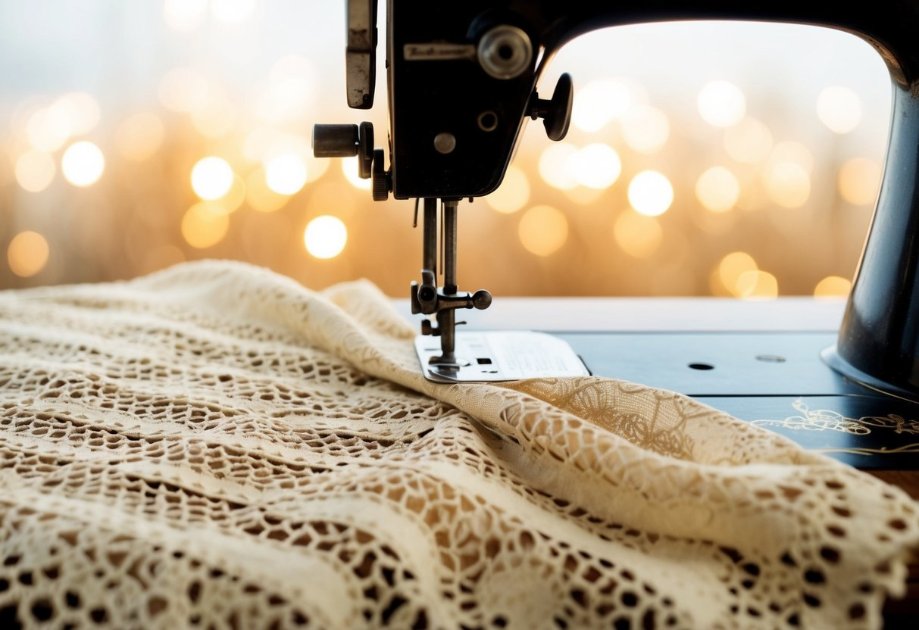
Eyelet fabric emerged centuries ago through intricate handwork and evolved into a symbol of luxury fashion. The fabric’s signature holes and embroidered patterns transformed from aristocratic decoration to widespread use in modern clothing.
Traditional Techniques
Broderie Anglaise, a traditional form of eyelet embroidery, gained prominence in 16th century Europe. Skilled artisans cut holes in fabric and hand-stitched around the edges to prevent fraying.
The technique became highly sought after during the Victorian era, when it adorned undergarments and delicate clothing. Rich families displayed their wealth through elaborate eyelet designs on clothing and household linens.
Craftspeople created patterns using basic tools:
- Sharp scissors for cutting holes
- Embroidery hoops for tension
- Fine needles for detailed work
- Cotton thread for durability
Modern Developments
The invention of the Schiffli embroidery machine in the 1800s revolutionised eyelet production. This mechanical marvel could create hundreds of detailed patterns quickly and precisely.
Today’s manufacturing combines traditional patterns with new techniques:
- Computer-aided design for precise patterns
- Laser cutting for clean holes
- Advanced embroidery machines for consistency
- Automated quality control systems
Modern eyelet fabric comes in various styles and materials. Manufacturers produce both vintage-inspired designs and contemporary patterns to meet diverse fashion needs.
Manufacturing Eyelet Fabric
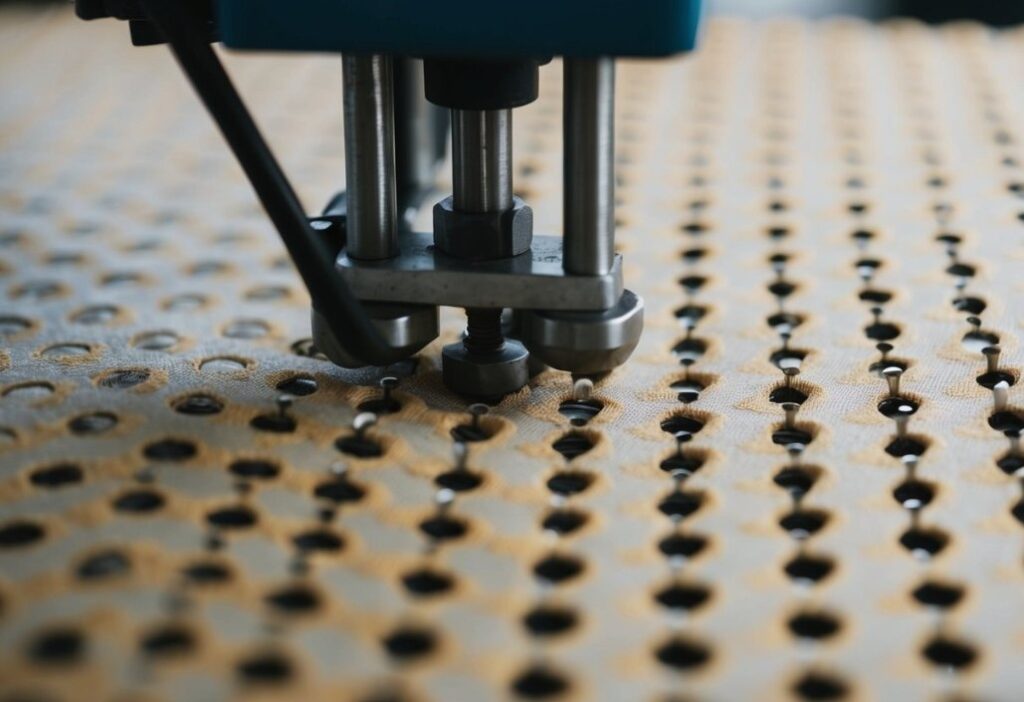
Eyelet fabric production involves creating decorative holes surrounded by embroidered edges in base fabric. The process starts with selecting a sturdy base material, typically cotton or cotton-polyester blends.
The main techniques used to create eyelet patterns include Cutwork, Whitework, and Schiffli Embroidery. Cutwork involves removing specific areas of fabric and securing the edges with stitching to prevent fraying.
Madeira Work is a traditional method where artisans cut holes in the fabric and wrap threads around the edges by hand. This technique creates intricate, detailed patterns but requires significant time and skill.
Modern manufacturing relies heavily on Schiffli machines. These specialised embroidery machines can create hundreds of eyelet patterns simultaneously. They first embroider the design, then use precise cutting tools to remove the fabric within the embroidered areas.
The manufacturing process follows these steps:
- Pattern design and digitisation
- Base fabric preparation
- Embroidery of the design edges
- Precise cutting of holes
- Quality inspection
- Finishing treatments
A special eyelet tool punches the holes and secures the embroidered rings around them. The fabric then undergoes finishing processes to ensure durability and prevent unravelling.
Uses and Applications
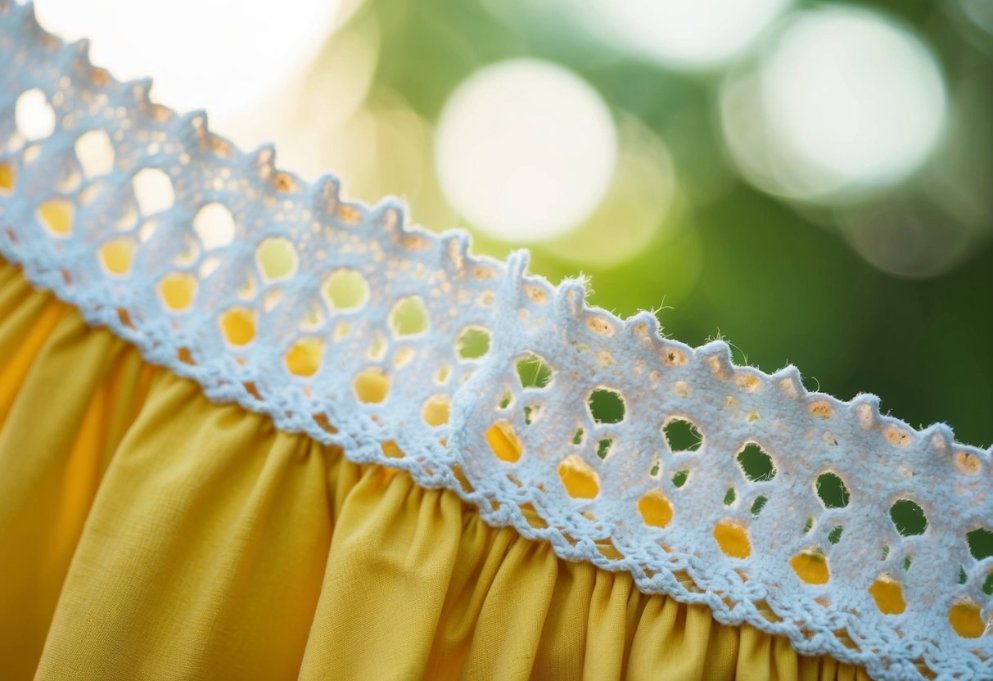
Eyelet fabric offers exceptional versatility across both fashion and interior design. Its distinctive perforated patterns and breathable nature make it a practical choice for creating stylish garments and enhancing home décor elements.
Fashion Industry
Eyelet fabric dresses and blouses are popular choices for summer wardrobes due to their excellent breathability. The fabric’s decorative cutouts create elegant details around necklines, sleeves, and hems.
Women’s clothing benefits most from eyelet fabric’s romantic aesthetic. Summer dresses made from this material provide comfort whilst maintaining a feminine appearance.
Vintage-style clothing particularly suits eyelet fabric. Skirts and tops featuring eyelet patterns add a timeless charm to any outfit.
The fabric works brilliantly for special occasion wear, with white eyelet being especially sought after for christening gowns and wedding accessories.
Home Décor
Eyelet fabric transforms ordinary home furnishings into elegant statement pieces. Curtains made from eyelet material filter light beautifully whilst adding texture to a room.
Table linens and cushion covers benefit from eyelet fabric’s decorative nature. The material’s intricate patterns create visual interest on tablecloths and decorative pillows.
Bedroom décor often incorporates eyelet fabric through bed skirts, pillow shams, and duvet covers. The fabric’s light and airy quality suits these applications perfectly.
Kitchen textiles like café curtains and table runners made from eyelet fabric add a charming cottage-style element to the space.
Styling and Care
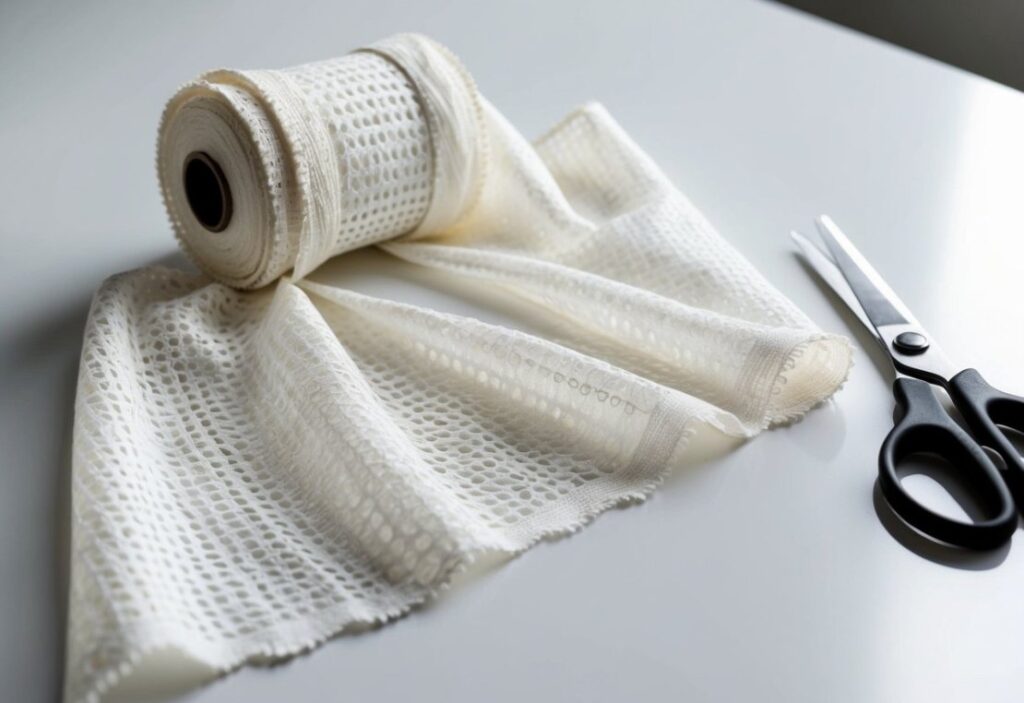
Eyelet fabric brings elegance and airiness to any wardrobe, with its delicate perforations and textural appeal making it perfect for both casual and dressy looks.
Fashion Tips
Cotton eyelet fabric works brilliantly for romantic summer dresses and flowing maxi styles. The semi-sheer nature of the fabric adds a vintage-inspired touch to any outfit.
Pair eyelet tops with:
- High-waisted jeans for a casual look
- A silk slip underneath for modesty
- Neutral-coloured undergarments to maintain the fabric’s crisp appearance
Create stylish DIY projects by using eyelet fabric for:
- Decorative throw pillows
- Pretty window curtains
- Delicate table linens
Maintaining Eyelet Garments
Handle eyelet fabric with special care to preserve its intricate patterns and texture. Machine wash in warm water with mild detergent.
- Use a gentle cycle setting
- Avoid harsh bleaches
- Iron on low heat whilst damp
- Store on padded hangers
For best results, hand washing is ideal for maintaining the fabric’s delicate embroidery and preventing damage to the eyelets.
Eyelet in Modern Design
Modern fashion has embraced eyelet fabric in fresh, creative ways. Contemporary silhouettes like tailored blouses, midi dresses, and structured skirts showcase this classic material.
Knit eyelet fabric offers unique properties with its four-way stretch and moderate drape. This variant creates a semi-sheer effect due to its mesh-like openings.
Designers frequently use eyelet in summer collections. The decorative patterns and designs make it especially appealing for women’s wear.
Popular Modern Applications:
- Structured day dresses
- Lightweight summer blouses
- Beach cover-ups
- Statement sleeves
- Decorative trim and panels
The intricate patterns range from traditional florals to geometric designs. These patterns give garments a distinctive, sophisticated appearance.
Many designers appreciate eyelet’s versatility. The fabric works well for both casual daywear and dressy occasions, making it a practical choice for varied wardrobes.
Frequently Asked Questions
Eyelet fabric comes in various materials, styles and uses while maintaining its signature perforated patterns with embroidered edges. This versatile textile serves both functional and decorative purposes in fashion and home décor.
What materials are utilised in the construction of eyelet fabric?
Cotton eyelet fabric remains the most common base material due to its crisp texture and breathability.
Knit eyelet varieties incorporate wool or cotton with four-way stretch properties.
Some modern eyelet fabrics use polyester-cotton blends for improved durability.
For what purposes is eyelet fabric typically employed?
The fabric excels in decorative clothing and home furnishings that benefit from its delicate appearance and ventilation properties.
Crafting and sewing projects often incorporate eyelet fabric for accent pieces and décor items.
By what other names is eyelet fabric known?
The fabric is sometimes called broderie fabric or Swiss embroidery in British textile circles.
Some retailers label it as perforated cotton or embroidered eyelet.
In what types of clothing is eyelet fabric most commonly found?
Summer dresses and blouses frequently feature eyelet fabric construction.
Children’s special occasion wear and christening gowns often incorporate eyelet details.
Decorative collars, cuffs and trim pieces regularly use eyelet fabric accents.
How does eyelet fabric differ from Broderie anglaise?
Eyelet fabric features simple circular holes with embroidered edges in geometric patterns.
Broderie anglaise typically includes more complex floral or botanical designs with varied hole shapes and sizes.
Is eyelet fabric considered ideal for warm weather attire?
The perforated nature of eyelet fabric provides natural ventilation and breathability.
The lightweight cotton construction helps maintain comfort in hot conditions.
The fabric’s airy quality makes it particularly suited for spring and summer garments.

